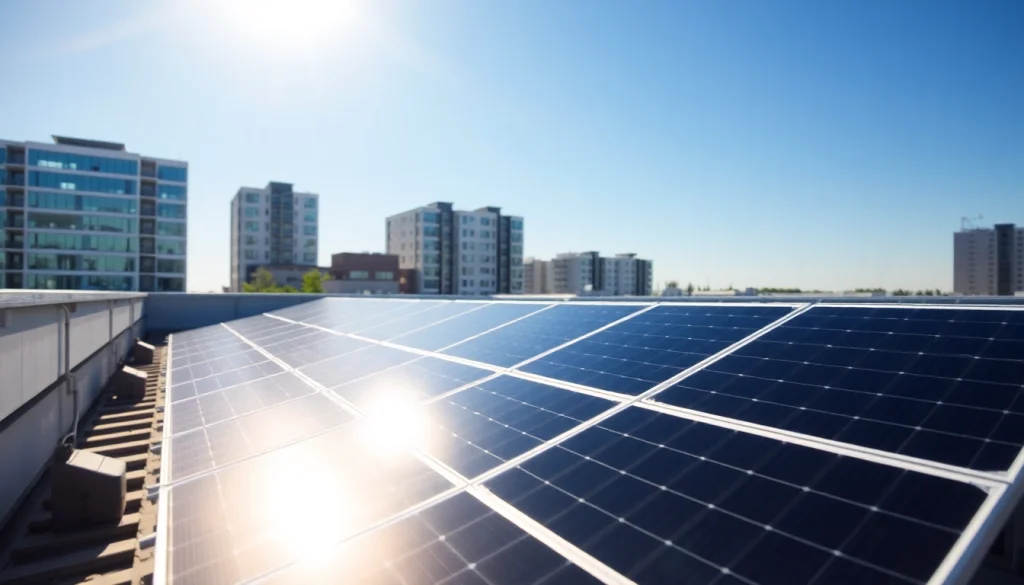Understanding Commercial Solar Basics
As the demand for sustainable energy solutions continues to rise, commercial solar has emerged as a viable option for businesses seeking to reduce their environmental footprint and energy costs. But what does commercial solar encompass, and how can it benefit your enterprise? This article will delve deep into the essentials of commercial solar energy, from its definitions and benefits to the finer details of selecting the right system for your organization.
What is Commercial Solar?
Commercial solar refers to solar energy systems installed on business premises, which can include rooftops, carports, and ground-mounted arrays. Unlike residential solar systems, which cater to individual homes, commercial solar systems are designed to produce larger amounts of electricity to meet the higher energy demands of businesses. These systems range from kilowatt-sized installations suitable for small enterprises to megawatt-scale systems that can power large corporations.
Typically, commercial solar installations are specifically engineered to meet the unique power needs of a business and may involve different components than residential systems, such as larger solar panels and integrated storage solutions. The functionality of these systems can include net metering, allowing businesses to sell excess energy back to the grid, thus creating additional revenue streams.
Key Benefits of Commercial Solar Energy
The benefits of adopting commercial solar energy are substantial and can impact both the financial and environmental aspects of a business:
- Cost Savings: Solar systems reduce electricity bills significantly. Businesses can save thousands annually, translating to lower operational costs.
- Tax Incentives and Rebates: Many governments offer tax credits, grants, and rebates to encourage renewable energy adoption, reducing upfront costs and enhancing return on investment (ROI).
- Energy Independence: Generating your own electricity mitigates reliance on local utility companies and protects against energy price fluctuations.
- Environmental Impact: Transitioning to solar reduces greenhouse gas emissions, contributing to a sustainable future and enhancing a company’s brand image as environmentally responsible.
- Increased Property Value: Installing solar energy systems can enhance property values, making the business more attractive to potential buyers or investors.
Common Myths Debunked
Despite the clear advantages of commercial solar, several misconceptions persist that may deter businesses from considering this energy source:
- Solar is Too Expensive: While upfront costs can be substantial, tax incentives, financing options, and long-term savings make solar systems economically viable.
- Solar Requires Too Much Space: Modern solar technologies such as thin-panel arrays and solar canopies make it possible to implement solar solutions in limited spaces.
- Solar is Only Effective in Sunny Areas: Solar panels can generate electricity even in cloudy conditions, and improved technologies continue to enhance their efficiency.
Choosing the Right Commercial Solar System
Identifying the right solar solution begins with understanding your energy needs and the appropriate technologies that can meet them. Here’s what to consider:
Types of Commercial Solar Panels
Commercial solar panels generally fall under three main categories:
- Monocrystalline Panels: Known for high efficiency and aesthetics, these panels are made from a single crystal structure, allowing for higher power output with less space.
- Polycrystalline Panels: Comprised of multiple crystal structures, these are typically less expensive but offer lower efficiency compared to monocrystalline options.
- Thin-Film Panels: These flexible panels are lightweight and can be applied to a variety of surfaces. While they may have lower efficiency, they are increasingly used for commercial applications due to their versatility and cost-effectiveness.
Factors Influencing System Size
The size of a commercial solar system is influenced by numerous factors, including:
- Energy Consumption: Historical energy consumption data helps determine the appropriate system size needed to meet a business’s energy demands.
- Available Space: The area available for installation is critical; rooftops and ground spaces can dictate panel configurations.
- Battery Storage Needs: If energy storage solutions are desired, additional space and budget considerations come into play.
Selecting a Reliable Installer
Choosing the right installer is essential to ensure a successful solar project. Here are tips for selecting a quality installer:
- Check Experience and Credentials: Look for installers with a strong portfolio and certifications from recognized industry bodies.
- Read Reviews and Testimonials: Customer feedback can provide insights into the installer’s reliability and quality of work.
- Request Multiple Quotes: Get quotes from several contractors to compare pricing, services, and warranty options.
Financing Your Commercial Solar Project
The financial viability of commercial solar projects can vary significantly based on the chosen financing method. Understanding costs, available incentives, and projected ROI is vital for informed decision-making.
Understanding the Costs
The initial costs for commercial solar projects can range widely—from $140,000 to over $500,000 depending on size and complexity. These costs include:
- Equipment: The price of panels, inverters, and other necessary components contributes significantly to overall costs.
- Installation: Labor costs for mounting systems, electrical work, and connection to the grid.
- Maintenance: Regular upkeep and inspections are necessary to ensure long-term performance.
Incentives and Tax Benefits
Government incentives can significantly alleviate the financial burden associated with solar installations. Key incentives include:
- Investment Tax Credit (ITC): Businesses can deduct a percentage of their solar system costs from federal taxes.
- State Rebates: Many states offer direct rebates or grants, further reducing upfront expenses.
- Accelerated Depreciation: Businesses can often depreciate the cost of solar systems over a short period, providing substantial tax relief.
Long-term ROI on Commercial Solar
Investing in solar energy not only has immediate financial benefits but also offers a robust long-term ROI. Key factors to consider include:
- Energy Savings: Most businesses recoup their initial investment within a few years through significant reductions in energy bills.
- System Longevity: High-quality commercial solar systems can last 25 years or more, allowing businesses to capitalize on electricity savings over decades.
- Energy Resilience: A solar system can serve as a hedge against rising electricity costs, providing predictable energy expenses for the future.
Implementing and Managing Your Solar System
Once a commercial solar system is installed, effective management is crucial for maximizing performance and longevity. Here’s a detailed look at the process:
Installation Process Overview
Installing a commercial solar system typically follows these steps:
- Site Assessment: A preliminary evaluation of the installation site is conducted to determine suitability.
- Design Development: Custom designs are created to match the energy profile of the business and available installation space.
- Permitting and Approvals: Necessary local permits and approvals are obtained before installation commencement.
- Installation: The physical setup of solar panels and related equipment is executed by professional installers.
- System Commissioning: Final tests are conducted to ensure operational efficiency and compliance with regulations.
Monitoring Your Solar Energy Production
Effective monitoring is vital to ensure your solar system operates at peak performance. Invest in a monitoring system that tracks:
- Energy Generation: Daily production metrics can help assess system efficiency and productivity.
- Performance Indicators: Track performance ratios and compare actual production to expected generation.
- System Health: Continuous monitoring can alert users to potential issues and service needs promptly.
Maintenance Best Practices
Regular maintenance helps sustain efficiency and prolongs the life of your solar investment. Best practices include:
- Regular Cleaning: Dust, debris, and bird droppings can accumulate on panels and hinder performance; regular cleaning is essential.
- Annual Inspections: Schedule yearly evaluations by a qualified technician to check system components and performance.
- Monitor Weather Impacts: Post-storm inspections can help assess damage or obstruction that can affect system functionality.
The Future of Commercial Solar Energy
The landscape of commercial solar energy is continuously evolving, presenting new opportunities and challenges. Understanding future trends can help businesses stay ahead.
Emerging Technologies in Solar
Advances in technology are crucial for enhancing the performance of solar systems:
- Solar Battery Storage: Increasing adoption of battery technology allows businesses to store excess energy for later use, improving energy resilience.
- Building Integrated Photovoltaics (BIPV): Solar materials that double as building components (like roof tiles and windows) are becoming more common, expanding installation options.
- Smart Grid Integration: Developing connections between solar systems and smart grids enhances energy distribution efficiency and reliability.
Trends Affecting Commercial Solar Adoption
Several trends are shaping the future of commercial solar energy:
- Corporate Sustainability Goals: As businesses aim to reduce carbon footprints, the adoption of solar energy solutions is rapidly increasing.
- Community Solar Programs: Increasingly popular, these programs allow businesses to invest in large-scale solar farms without needing to install systems on-site.
- Legislative Support: Continued government incentives encourage solar adoption and make it more accessible for businesses of all types.
Global Impact of Commercial Solar Initiatives
The push for commercial solar is not only a trend in the U.S. but globally. Major impacts include:
- Employment Growth: The renewable energy sector, particularly solar, is a significant source of job creation worldwide.
- Energy Access: Solar initiatives provide clean energy options for developing regions, enhancing energy access and supporting infrastructure development.
- Climate Change Mitigation: Widespread adoption of solar energy contributes significantly to efforts to combat global warming by reducing dependency on fossil fuels.
In conclusion, commercial solar energy presents a host of opportunities for businesses looking to advance toward sustainable practices. By understanding the systems available, the potential savings, and the impact of innovative technologies, you can make a sound investment that not only offers immediate benefits but contributes to a sustainable future.


